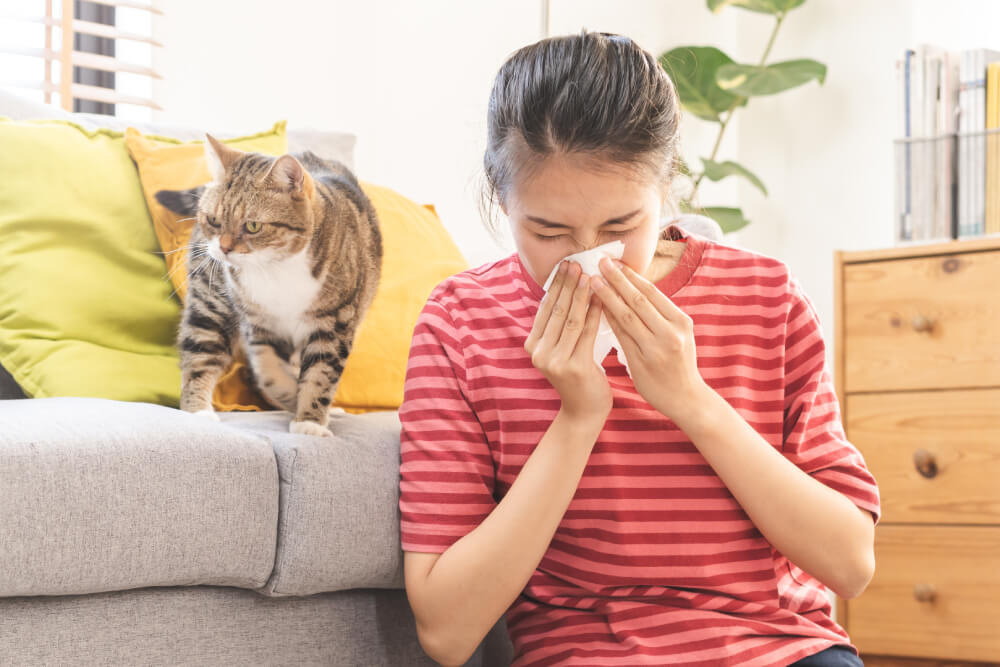How to Remove Pet Allergens in Your Home
For 20%-30% of pet owners, our adorable, cuddly companions might be the unexpected cause behind frequent sneezes and allergy symptoms. But don’t worry–there are plenty of easy and effective ways to reduce pet allergens in your home.
Whether or not you have allergies to your pet, this article is for you! Even if you don’t experience noticeable allergic reactions, long-term exposure to pets can still lead to respiratory irritation and lingering odors. Knowing how to keep your home’s air clean can make a huge difference in your overall well-being. By reading this blog, you’ll learn practical tips to help you enjoy your furry friends while maintaining a clean and healthy home.
What are Pet Allergens?
If you’ve ever found yourself sneezing or sniffling around your furry friend, you might be dealing with pet dander—a sneaky allergen that’s often the culprit behind those allergy symptoms.
Pet dander consists of tiny, lightweight flakes of skin that pets shed. These flakes are so small that they’re nearly invisible to the naked eye, often measuring just 2.5 micrometers in diameter (a size category known as PM2.5). Because of their minute size, pet dander can float effortlessly through the air and settle in the most unexpected places around your home.
What makes pet dander particularly tricky is its persistence. Unlike larger particles that might settle quickly, dander can remain airborne for extended periods, drifting through your home and landing on furniture, carpets, and other surfaces. This means that even if you meticulously clean, there will always be some dander floating around, making it a constant presence in your living space.
Even if you have a breed that is “hypoallergenic,” it’s important to remember that no pet is completely free of dander. Every pet produces it, and no amount of grooming or cleaning will entirely eliminate it from your indoor environment.
How Pet Dander Affects Your Indoor Air Quality
Ever wonder why it feels like your pet’s presence lingers long after they’ve left the room? It’s not just their adorable personality—it’s also their dander. This tiny, almost invisible stuff can hang around in the air way longer than you might expect, affecting what you’re breathing in.
The American Lung Association explains that pet dander is particularly tricky because it’s microscopic and jagged. Think of it as being so small (around PM2.5 size) and oddly shaped that it floats easily through the air and lands on pretty much everything—furniture, bedding, fabrics, you name it. It can even hitch a ride on things you bring in and out of your home.
What’s more, even after you’ve cleaned, those little particles can still be floating around. A slight breeze or a bit of movement can send them back into the air, making it hard to completely get rid of them.

Recognizing the Symptoms
Sharing your home with a pet can bring immense joy, but it can also lead to some unexpected health challenges. From respiratory irritations to skin reactions, recognizing these symptoms can help you take proactive steps to ensure both you and your furry friend stay happy and healthy.
Here’s what you need to watch out for:/p>
- Allergic Reactions: Pet dander is a common allergen that can trigger sneezing, coughing, nasal congestion, and asthma attacks.
- Skin Issues: Contact with pet dander can cause itchy, red, or inflamed skin. People with allergies may develop dermatitis, rashes, or hives.
- Worsening Asthma: For those with asthma, pet dander can exacerbate symptoms and increase the frequency of asthma attacks.
- Respiratory Irritation: Even without allergies, pet hair and dander can irritate your respiratory system, especially if you have asthma or other respiratory conditions.
- Chronic Inflammation: Long-term exposure to pet dander can contribute to chronic sinusitis, leading to persistent nasal congestion and discomfort.
Taking steps to protect your health and improve the air you breathe in the presence of pet dander can make a significant difference. By actively managing pet dander, you’ll not only enhance your own air quality but also ensure a healthier living environment. Your efforts will contribute to cleaner air and a more comfortable home. Additionally, these measures benefit your pet’s health as well—pets are also affected by their own dander and other indoor pollutants. Ensuring good air quality helps both you and your furry friend live healthier, happier lives.
- Groom Your Pet Regularly:
- Bathing: Bathe your pet regularly with pet-friendly shampoo to reduce odor and dander. Be sure not to over-bathe, as this can irritate their skin.
- Brushing: Brush your pet outdoors or in a designated area to minimize dander spread indoors. Regular grooming reduces loose fur and dander.
- Regular Cleaning:
- Vacuum Frequently: Vacuum carpets, rugs, and upholstery at least once a week.
- Wash Bedding: Regularly wash your pet’s bedding and your own to remove dander and odors.
- Dust and Wipe Surfaces: Use damp cloths to wipe down surfaces where dander may accumulate.
- Invest in an Air Purifier:
- Breathe Better with AirDoctor: Our most popular air purifier is the AD3500. But we have multiple air purifiers depending on your space and needs. If your pets are welcome within all parts of your house, we provide different purifiers for different spaces such as bedrooms, open-floor concepts, etc.
Remember, a well-maintained home is not just about keeping allergens at bay—it’s about enhancing the quality of life for both you and your pet. Cleaner air means fewer allergy symptoms, better respiratory health, and a more enjoyable time with your beloved pet. By taking these steps, you’re making a lasting difference in your well-being and ensuring that your home remains a sanctuary for both you and your four-legged friend. So go ahead, embrace these practices and enjoy the companionship of your pet with peace of mind, knowing that you’re fostering a healthier, happier home.
*https://medium.com/@hellowynd/your-pets-may-affect-your-indoor-air-quality-85b77b2a7962
**https://www.lung.org/clean-air/indoor-air/indoor-air-pollutants/pet-dander

